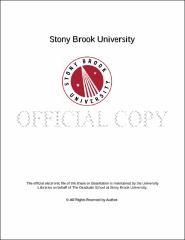| dc.identifier.uri | http://hdl.handle.net/11401/76646 | |
| dc.description.sponsorship | This work is sponsored by the Stony Brook University Graduate School in compliance with the requirements for completion of degree. | en_US |
| dc.format | Monograph | |
| dc.format.medium | Electronic Resource | en_US |
| dc.language.iso | en_US | |
| dc.publisher | The Graduate School, Stony Brook University: Stony Brook, NY. | |
| dc.type | Dissertation | |
| dcterms.abstract | The mergers of binary white dwarf systems are potential progenitors of astrophysical explosions such as Type Ia supernovae. These white dwarfs can merge either by orbital decay through the emission of gravitational waves or by direct collisions as a result of orbital perturbations. The coalescence of the stars may ignite nuclear fusion, resulting in the destruction of both stars through a thermonuclear runaway and ensuing detonation. The goal of this dissertation is to simulate binary white dwarf systems using the techniques of computational fluid dynamics and therefore to understand what numerical techniques are necessary to obtain accurate dynamical evolution of the system, as well as to learn what conditions are necessary to enable a realistic detonation. For this purpose I have used software that solves the relevant fluid equations, the Poisson equation for self-gravity, and the systems governing nuclear reactions between atomic species. These equations are modeled on a computational domain that uses the technique of adaptive mesh refinement to have the highest spatial resolution in the areas of the domain that are most sensitive to the need for accurate numerical evolution. I have identified that the most important obstacles to accurate evolution are the numerical violation of conservation of energy and angular momentum in the system, and the development of numerically seeded thermonuclear detonations that do not bear resemblance to physically correct detonations. I then developed methods for ameliorating these problems, and determined what metrics can be used for judging whether a given white dwarf merger simulation is trustworthy. This involved the development of a number of algorithmic improvements to the simulation software, which I describe. Finally, I performed high-resolution simulations of typical cases of white dwarf mergers and head-on collisions to demonstrate the impacts of these choices. The results of these simulations and the corresponding implications for white dwarf mergers as astrophysical explosion progenitors are discussed. | |
| dcterms.available | 2017-09-20T16:50:52Z | |
| dcterms.contributor | Zingale, Michael | en_US |
| dcterms.contributor | Calder, Alan | en_US |
| dcterms.contributor | Kiryluk, Joanna | en_US |
| dcterms.contributor | Khairoutdinov, Marat. | en_US |
| dcterms.creator | Katz, Maximilian Peter | |
| dcterms.dateAccepted | 2017-09-20T16:50:52Z | |
| dcterms.dateSubmitted | 2017-09-20T16:50:52Z | |
| dcterms.description | Department of Physics | en_US |
| dcterms.extent | 114 pg. | en_US |
| dcterms.format | Application/PDF | en_US |
| dcterms.format | Monograph | |
| dcterms.identifier | http://hdl.handle.net/11401/76646 | |
| dcterms.issued | 2016-12-01 | |
| dcterms.language | en_US | |
| dcterms.provenance | Made available in DSpace on 2017-09-20T16:50:52Z (GMT). No. of bitstreams: 1
Katz_grad.sunysb_0771E_12963.pdf: 3362833 bytes, checksum: c6ff53600e20411d1251c47e8bf96ed1 (MD5)
Previous issue date: 1 | en |
| dcterms.publisher | The Graduate School, Stony Brook University: Stony Brook, NY. | |
| dcterms.subject | Computational fluid dynamics, Nuclear astrophysics, Supernovae | |
| dcterms.subject | Astrophysics -- Physics | |
| dcterms.title | White Dwarf Mergers on Adaptive Meshes | |
| dcterms.type | Dissertation | |

